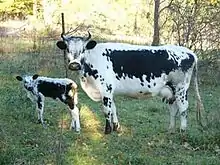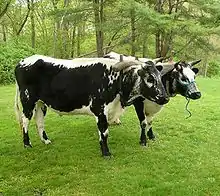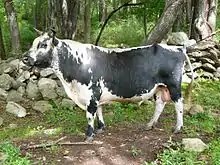Randall Lineback
The Randall Lineback or Randall is an American breed of cattle. It originated in Sunderland, Vermont, and is critically endangered.[4]:289[5]:278
 Cow and calf | |
| Conservation status |
|
|---|---|
| Other names | |
| Country of origin | United States |
| Distribution | Vermont |
| Traits | |
| Horn status | horned |
| |


Origin
The Randall is a breed of purebred cattle developed in Sunderland, Vermont, USA, on the farm of Samuel Randall, and later his son, Everett Randall. It is a rare breed, thought to descend from the local cattle common in New England in the nineteenth century. The Randall family kept a closed herd for over 80 years.
The Randall cattle were bought after the death of Everett Randall by a couple in Massachusetts, who were not interested in keeping them, but merely wanting to make money off of them. Cynthia Creech, then living in Tennessee, to preserve the genetics from extinction stepped in to purchase most of the remaining animals including 5 cows, 4 heifers, 2 yearling bulls, a weanling bull, 2 other calves and a herd bull. Unfortunately most of the cattle were in critical condition, two of the cows died while in Massachusetts, one broke her horn during the trip, many were covered in lice and blood. But due to Cynthia's hard work they were turned into a wonderful herd of working cattle. [6][7]
Randall Cattle are an all-purpose breed, meaning they originally served as dairy, meat, and draft animals. From fewer than 20 animals the breed population has increased to over 350 breeding females.
Characteristics
Randall cattle are quite variable in size and conformation and have a constitution that is suited to the New England climate. Randalls on average are medium in size with the cows weighing about 600-1100 lbs. and bulls weighing from 1000 to 1800 lbs. or more. Randall cattle have a "Colour-sided" lineback pattern, black markings on a white base, varying from almost white to very dark. Other subtle shades such as blue, mahogany, and gray have been observed, and there are now a number of recessive reds.
Randall meat characteristics can vary between different family lines, for example some produce a lean carcass with yellow fat and others produce a beefier well marbled carcass.
Calving difficulties are rare, and metabolic disorders have not been seen. They have strong maternal and survival instincts, high intelligence, and are very docile when handled regularly.
This breed is uniquely adapted to extensive or low input farming systems. Historically, the most suitable and natural environment for these cattle has been on small scale forage-based farms, subsistence farms, and homesteads. It is on such farms and homesteads that the unique genetic attributes of the Randalls can be fully expressed. .[8]
Breed distribution
Most Randall cattle are currently found in the Eastern United States and Canada. While breed numbers are greatly improved, the breed remains critically endangered.
References
- Barbara Rischkowsky, D. Pilling (eds.) (2007). List of breeds documented in the Global Databank for Animal Genetic Resources, annex to The State of the World's Animal Genetic Resources for Food and Agriculture. Rome: Food and Agriculture Organization of the United Nations. ISBN 9789251057629. Archived 23 June 2020.
- Breed data sheet: Randall Lineback / United States of America (Cattle). Domestic Animal Diversity Information System of the Food and Agriculture Organization of the United Nations. Accessed November 2020.
- Randall or Randall Lineback. The Livestock Conservancy. Archived 7 November 2020.
- Janet Vorwald Dohner (2001). The Encyclopedia of Historic and Endangered Livestock and Poultry Breeds. New Haven, Connecticut; London: Yale University Press. ISBN 0300088809.
- Valerie Porter, Lawrence Alderson, Stephen J.G. Hall, D. Phillip Sponenberg (2016). Mason's World Encyclopedia of Livestock Breeds and Breeding (sixth edition). Wallingford: CABI. ISBN 9781780647944.
- http://ngm.nationalgeographic.com/2011/07/food-ark/cattle-breeds#/5
- Cynthia's Randall Cattle Pages
- Randall Cattle. Milk production on grass. Philip B. Lang PDF Archived 2007-09-14 at the Wayback Machine